Table of Contents
ToggleWhen we talk about the movers and shakers in STEM, it’s easy to picture a lineup of familiar faces. But there’s a whole group of lesser-known innovators. The women whose groundbreaking contributions have shaped the world the way it is today. Women have long been instrumental in pushing the boundaries of science, technology, engineering, and mathematics, often without the recognition they rightly deserve.
Did you know, as of 2023, women only make up about 28% of the workforce in STEM fields? This number is a stark reminder of the gender gap that still exists, despite the significant strides we’ve made towards equality and representation. While progress is evident, the statistics highlight how much work remains to ensure truly inclusive opportunities for all. It’s more than just a number—it’s a call to action to shine a light on the achievements of women who’ve paved the way and to inspire a new generation to dream big.
This blog aims to celebrate these remarkable women. Their journeys, marked by resilience, innovation, and unparalleled vision, deserve recognition and celebration. Read below to explore the lives and contributions of these extraordinary women in STEM.
Rosalind Franklin: Discovering the Double Helix Structure of DNA
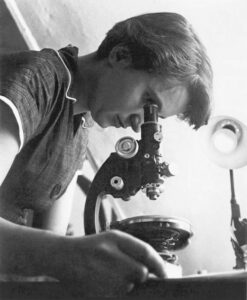
Rosalind Franklin was a woman of exceptional intellect and determination whose work played an important role in one of the 20th century’s most significant scientific revelations: the structure of DNA. Here’s a look at her journey:
Early Career
Born into a forward-thinking family in London in 1920, Franklin was destined for greatness. Her path took her to Cambridge University, where she dove into the world of physics and chemistry. Franklin’s early career was dedicated to understanding the microstructures of coal, work that would lay the groundwork for her later contributions to biology.
Defining Moment
In 1951, Franklin found herself at King’s College London amidst a male-dominated research environment. Here, she applied her expertise in X-ray crystallography to DNA, a molecule that was just beginning to reveal its secrets. Franklin’s meticulous approach led to “Photo 51,” an X-ray diffraction image that would become the cornerstone of DNA structure discovery.
Despite the clarity and importance of her findings, Franklin’s contribution was initially overshadowed by her male colleagues, Watson and Crick, who received a Nobel Prize for the discovery.
Legacy and Recognition
Franklin’s work ethic and dedication to science were awe-inspiring. She once said, “Science and everyday life cannot and should not be separated.” This philosophy drove her to not only excel in her field but also to apply her findings in ways that mattered.
Her posthumous recognition has grown, painting a picture of a scientist whose work was essential to understanding life itself.
Grace Hopper: Revolutionizing Computer Programming

Grace Hopper’s transition from mathematics to computer science wasn’t just a career change; it was a leap into the future. With a Ph.D. in mathematics from Yale and a professorship at Vassar College under her belt, Hopper’s world changed with World War II. Joining the Navy Reserves, she was introduced to the Mark I computer, sparking a fascination that would redefine her legacy and the course of computing history.
Breakthroughs
Hopper’s vision extended beyond the complex, machine-specific codes of her time. She foresaw a world where computer programming was accessible to all. This led her to develop the first compiler, a tool that transformed programming into a simpler, more universal language. This innovation paved the way for COBOL, a programming language that revolutionized data processing and opened up new realms of possibilities in computing.
Honors and Legacy
Throughout her career, Hopper received numerous accolades, including the Presidential Medal of Freedom, for her contributions to computer science. Her legacy extends beyond her awards, living in the generations of programmers and computer scientists who follow in her footsteps, inspired by her mantra to challenge conventions and innovate.
Mae Jemison: From Space to Global Health
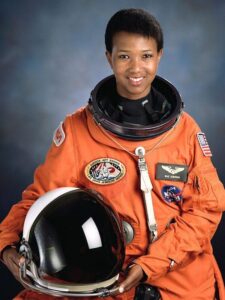
Mae Jemison’s journey is a tale of curiosity and the power of following one’s dreams. From the streets of Chicago to the vastness of space, Jemison’s aspirations knew no limits. Inspired by pioneers like Guy Bluford, Jr. Sally Ride, and the fictional Lieutenant Uhura from Star Trek, she set her sights on the stars. She eventually became the first African American woman to travel in space.
Journey to NASA
As a child, Jemison’s family encouraged her interests in science and mathematics despite discouragement from some teachers.
Jemison’s academic prowess led her to Stanford University at just 16, where she faced racial discrimination but remained undeterred. She graduated with degrees in Chemical Engineering and African American Studies. Her journey continued at Cornell University Medical School, further fueled by her work in the Peace Corps in West Africa.
Jemison’s medical and scientific expertise, combined with her spirit, paved her way to NASA—where she broke barriers and fulfilled her dream of space travel.
Space Mission and Beyond
On September 12, 1992, Jemison took her historic flight aboard the Endeavour. This not only marked her as the first African American woman in space but also showcased her as an important figure in the intersection of science, technology, and social change.
During her mission, Jemison conducted experiments that contributed to our understanding of health and science in microgravity. Following NASA, she continued to impact the world through her work in technology and healthcare, founding companies and teaching at Dartmouth College.
Advocacy and Impact
Jemison’s influence extends far beyond her space mission. She has tirelessly worked to promote diversity in STEM, inspiring women and girls to pursue their dreams in science and beyond. Through educational programs like The Earth We Share, Jemison has championed the cause of inclusive science education, demonstrating that the sky is not the limit. “Never be limited by other people’s limited imaginations,” Jemison advises, a mantra she lives by, pushing boundaries and encouraging the next generation to dream big.
Tu Youyou: A Lifesaving Discovery in Medicine
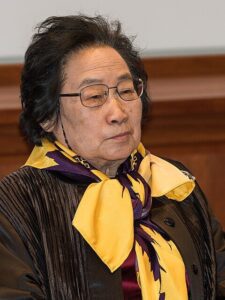
Tu Youyou’s story is one of perseverance, innovation, and a deep commitment to saving lives. In a male-dominated field and without formal training in pharmacology or a medical degree, Tu took on a self-taught journey that would lead to one of the most significant medical breakthroughs of the 20th century—the discovery of artemisinin, a drug that has saved millions from malaria.
Overcoming Barriers
Born in Ningbo, China, in 1930, Tu’s passion for medicine was kindled early on, despite a two-year break from her studies due to tuberculosis. Determined to find cures for the diseases that plagued humanity, she pursued pharmacology at Beijing Medical College.
Her career at the Academy of Traditional Chinese Medicine was marked by her unique approach of blending ancient Chinese medical texts with modern scientific methods. This approach led her and her team to rediscover and extract artemisinin from sweet wormwood (an ancient remedy for “intermittent fevers” indicative of malaria).
Nobel Prize-Winning Work
Tu’s work on Project 523 aimed to find a treatment for malaria resistant to existing drugs, By carefully examining ancient texts, Tu hypothesized that the traditional method of boiling might be damaging the active component in wormwood. This led to her groundbreaking discovery of artemisinin.
Tu even tested the compound on herself first, showing her deep dedication to her research. “Chinese medicine will help us conquer life-threatening diseases worldwide,” Tu stated, emphasizing the worldwide significance of her work.
Global Recognition
Tu’s receipt of the Nobel Prize in Physiology or Medicine in 2015 was a long-overdue acknowledgement of her contribution to global health. Her discovery of artemisinin has been hailed as the most important pharmaceutical intervention in the last half-century.
Gitanjali Rao: A New Generation’s Innovator

Gitanjali Rao, at just 15 years old, has already left a mark on the world of science and innovation. Recognized as America’s Top Young Scientist when she was only 11, Rao’s journey began with a passion for solving the problems she saw in the world around her. Her early interest in STEM led her to create solutions with the potential to change lives, including Tethys, a device designed to detect lead in drinking water, and Kindly, an app aimed at preventing cyberbullying.
Youthful Ingenuity
From an early age, she was driven by the question of how science and technology could be used to create social change. Her inquisitive nature and refusal to accept the status quo led her to explore carbon nanotube sensor technology and its applications in detecting harmful substances in water.
Innovations for Social Good
Rao’s inventions reflect her commitment to addressing societal issues. Tethys, her early lead detection tool, shows her approach to using science for the public good. Similarly, her anti-cyberbullying app, Kindly, uses AI to identify and regulate bullying behavior online by offering users a chance to reconsider their words.
Inspiring the Future
Beyond her inventions, Rao’s work as an advocate for STEM education stands out. Through workshops that have reached tens of thousands of students worldwide, she emphasizes a five-step innovation process to empower young minds. Rao’s vision extends beyond her own projects; she aims to create a global community of young innovators dedicated to solving the world’s most pressing problems. Her message is clear: innovation is necessary, and with determination and creativity, anyone can contribute to making a difference.
Jennifer Doudna: Pioneering CRISPR-Cas9 Gene Editing
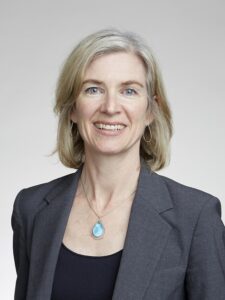
Jennifer Doudna, a biochemist, has revolutionized the field of genetics with the development of CRISPR-Cas9, a powerful gene-editing technology. Her journey in biochemistry, marked by curiosity and meticulous research, led to a discovery that has the potential to transform medicine by allowing for precise, efficient modifications of DNA to treat genetic disorders.
Pathway to Discovery
Doudna’s path was shaped by her early work on RNA, which eventually led her to explore the mechanisms of CRISPR, a bacterial immune system. Collaborating with Emmanuelle Charpentier, Doudna harnessed CRISPR-Cas9 as a tool for genome editing. This enabled scientists to make targeted changes to the genome with unimagined precision. This discovery not only opened new avenues for research but also posed significant ethical questions about the potential to alter human DNA.
Scientific Breakthrough
The development of CRISPR technology represents a major leap forward in genetic engineering. By providing a method to edit DNA accurately and efficiently, Doudna’s work has laid the foundation for treating a wide range of genetic disorders, offering hope for cures that were once thought to be beyond reach.
The implications of this technology extend far beyond medicine, with potential applications in agriculture, biofuel production, and more, highlighting the transformative power of genetic editing.
Awards and Influence
Doudna’s contributions to science have been recognized with many awards, including the Nobel Prize in Chemistry, which she shared with Emmanuelle Charpentier. Beyond her scientific achievements, Doudna has played a key role in ethical discussions surrounding gene editing.
She advocates for the responsible use of CRISPR technology, emphasizing the need for a cautious approach to editing human embryos and the importance of considering the long-term implications of genetic modifications.
Mary Jackson: Making Her Mark at NASA
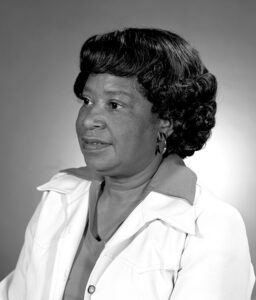
Mary Jackson carved a unique path at NASA, starting her journey in a segregated computing unit and rising to become the agency’s first African American female engineer. Her story is not just about breaking barriers but about sheer determination and passion for science.
Early Days and Challenges
After graduating with degrees in Mathematics and Physical Science from Hampton Institute, Jackson faced the daunting barriers of segregation and gender bias. She began her career in a segregated computing unit, where her brilliance and dedication quickly shone through.
Despite the systemic obstacles, she never lost sight of her aspirations, famously asserting, “I plan on being an engineer at NASA…I have no choice but to be the first.”
Contributions to Space Missions
Mary’s brilliance shone in her work on NASA’s space missions. She turned her focus to the science of how air moves around aircraft and spacecraft, improving the safety and success of America’s ventures into space. Her work was key during the critical stages of the Mercury and Apollo missions, ensuring that astronauts returned safely home.
A Legacy of Inclusion and Recognition
Beyond her engineering feats, Jackson was a strong advocate for equality, working tirelessly to improve opportunities for women and minorities in science and engineering.
Her posthumous recognitions, including the Presidential Medal of Freedom and her portrayal in “Hidden Figures,” underscore her monumental contributions to NASA and her role in advancing civil rights. “Mary never accepted the status quo,” remarked NASA Administrator Jim Bridenstine, highlighting her relentless pursuit of change and equality.
Fabiola Gianotti: Leading the Hunt for the Higgs Boson
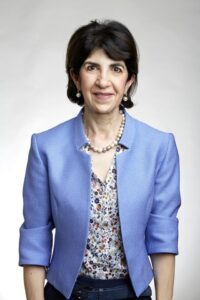
Fabiola Gianotti, a trailblazer in the world of particle physics, rose to become the first female Director-General of CERN, home to some of the world’s most ambitious physics experiments.
Journey to the Top
Growing up in Italy, Fabiola was fascinated by the mysteries of the universe. Her journey in physics took her from the University of Milano to the forefront of particle physics at CERN. Here, she led the ATLAS experiment, which was part of a historic discovery that would change science forever: the Higgs boson particle. This elusive particle was key to understanding why things have mass, answering a question that had puzzled scientists for decades.
The Discovery That Changed Everything
In 2012, under Fabiola’s guidance, the ATLAS team announced they had found the Higgs boson. This wasn’t just a win for Fabiola and her team; it was a victory for scientists everywhere. It proved a long-standing theory and opened new doors for understanding the universe. Fabiola often speaks about the teamwork and global collaboration that made this discovery possible, highlighting the power of collective effort in science.
Leading with a Vision
As the leader of CERN, Fabiola hasn’t just focused on scientific discovery. She’s worked hard to make science accessible and interesting to the public, encouraging people to see the beauty in physics. She’s also a strong advocate for diversity in science, believing that great minds come from all walks of life. Under her leadership, CERN continues to be a place where curiosity leads to discovery, aiming to solve the universe’s greatest mysteries
Wrapping Up – A Future Forged by Women in STEM
These women didn’t just make their mark in their respective fields—they reshaped the landscape of STEM for those who would follow. Their achievements play the critical role of diversity and inclusivity in driving scientific and technological progress.
Yet, the journey is far from over. With women still underrepresented in STEM, their stories serve as a call to action. It’s a reminder of the work that remains to ensure that everyone has the opportunity to contribute to and benefit from the advancements of science and technology.
BayOne steps into this narrative with a clear vision and a steadfast commitment to nurture the next wave of female STEM pioneers. Our initiative, #MakeTechPurple initiative, is a movement towards a future where gender disparity in STEM fields is a phenomenon of the past. We’re here to champion the cause of STEM education for girls, creating platforms where young women can envision themselves as the Rosalind Franklins, the Mae Jemisons, and the Jennifer Doudnas of tomorrow.

